Canon Scanfront 400 User Manual

INSTRUCTIONS
Please read this manual before using the scanner.
After you finish reading this manual, keep it in a safe place for future reference.

ENERGY STAR® Office Equipment Program
This program is for U.S.A and Canada. As an ENERGY STAR® Partner, Canon Electronics
Inc. has determined that this machine meets the ENERGY STAR® Program guidelines for energy efficiency.
The ENERGY STAR® Office Equipment Program is an international program that promotes energy saving through the use of computers and other office equipment.
The program backs the development and dissemination of products with functions that effectively reduce energy consumption. It is an open system in which business proprietors can participate voluntarily. The targeted products are office equipment, such as computers, monitors, printers, fax, machine, copiers, and scanners. The standards and logos are uniform among participating nations.
Under factory default settings, the scanner will enter Low Power mode after 12 minutes of inactivity. Although you can change the period of time before the scanner enters Low Power mode to up to 230 minutes, we recommend using the default setting.
FCC REGULATIONS (For 120 V model)
Network Scanner, Model M111271
This device complies with Part 15 of the FCC Rules. Operation is subject to the following two conditions: (1) This device may not cause harmful interference, and (2) this device must accept any interference received, including interference that may cause undesired operation.
Note: This equipment has been tested and found to comply with the limits for a Class B digital device, pursuant to Part 15 of the FCC Rules. These limits are designed to provide reasonable protection against harmful interference in a residential installation. This equipment generates, uses, and can radiate radio frequency energy and, if not installed and used in accordance with the instructions, may cause harmful interference to radio communications. However, there is no guarantee that interference will not occur in a particular installation. If this equipment does cause harmful interference to radio or television reception, which can be determined by turning the equipment off and on, the user is encouraged to try to correct the interference by one or more of the following measures:
–Reorient or relocate the receiving antenna.
–Increase the separation between the equipment and receiver.
–Connect the equipment into an outlet on a circuit different from that to which the receiver is connected.
–Consult the dealer or an experienced radio/TV technician for help.
Use of shielded cable is required to comply with class B limits in Subpart B of Part 15 of FCC Rules.
Do not make any changes or modifications to the equipment unless otherwise specified in the manual. If such changes or modifications should be made, you could be required to stop operation of the equipment.
Canon U.S.A. Inc.
One Canon Park, Melville, NY 11747, U.S.A. Tel. No. (800)652-2666
2

RADIO INTERFERENCE REGULATIONS (For 120 V models)
This digital apparatus does not exceed the Class B limits for radio noise emissions from digital apparatus as set out in the Interference-causing equipment standard entitled “Digital Apparatus”, ICES-003 of the Industry Canada.
RÈGLEMENT SUR LE BROUILLAGE RADIOÉLECTRIQUE (For 120 V models)
Cet appareil numérique respecte les limites de bruits radioélectriques applicables aux appareils numériques de Classe B prescrites dans la norme sur le matériel brouilleur: “Appareils Numériques”, NMB-003 édictée par l’Industrie Canada.
For CA, USA Only
Included battery contains Perchlorate Material - special handling may apply.
See http://www.dtsc.ca.gov/hazardouswaste/perchlorate/ for detail.
European Union (and EEA) only
This symbol indicates that this product is not to be disposed of with your household waste, according
to the WEEE Directive (2002/96/EC) and your national law. This product should be handed over to a designated collection point, e.g., on an
authorized one-for-one basis when you buy a new similar product or to an authorized collection site for recycling waste electrical and electronic equipment (EEE). Improper handling of this type of waste could have a possible negative impact on the environment and human health due to potentially hazardous substances that are generally associated with EEE. At the same time, your cooperation in the correct disposal of this product will contribute to the effective usage of natural resources. For more information about where you can drop off your waste equipment for recycling, please contact your local city office, waste authority, approved WEEE scheme or your household waste disposal service. For more information regarding return and recycling of WEEE products, please visit www.canon-europe.com/environment.
(EEA: Norway, Iceland and Liechtenstein)
Model Names
The following names may be provided for the safety regulations in each sales region of the Network Scanner. ScanFront 400: Model M111271
3

Trademarks
•Canon and the Canon logo are registered trademarks of Canon Inc. in the United States and may also be trademarks or registered trademarks in other countries.
•imageFORMULA is a trademark of Canon Electronics Inc.
•Microsoft, Windows, Internet Explorer, and Active Directory are registered trademarks or trademarks of Microsoft Corporation in the United States and other countries.
•Adobe, Acrobat, and Adobe Reader are registered trademarks or trademarks of Adobe Systems Incorporated in the United States and other countries.
•Other product and company names herein may be the trademarks of their respective owners.
Reproduction Warning
This device is designed to be used in a legal manner, in accordance with all applicable laws, including, but not limited to, counterfeit and copyright laws, as well as laws pertaining to national security.
Any person(s) found to have reproduced any of the following materials (regardless of whether such reproduction was intentional or not) for the purpose of misrepresenting such material as the original may be prosecuted in accordance with the applicable laws and regulations.
•Paper money or bank notes (domestic and foreign)
•Postage stamps, revenue stamps, or other similar stamps
•Stock certificates, bond certificates, promissory notes, cheques, or other valuable certificates
•Passports, licenses, or other certificates or documents issued by government officials or agencies
This is not an exhaustive list.
Canon is not responsible for how this scanner is used by an individual.
Please note that certain intellectual property is protected by copyright law, and copyrighted items may not be reproduced without the express permission of the copyright holder except for personal or household use under limited circumstances.
Disclaimers
The information in this document is subject to change without notice.
CANON ELECTRONICS INC. MAKES NO WARRANTY OF ANY KIND WITH REGARD TO THIS MATERIAL, EITHER EXPRESS OR IMPLIED, EXPECT AS PROVIDED HEREIN, INCLUDING WITHOUT LIMITATION, THEREOF, WARRANTIES AS TO MARKETABILITY, MERCHANTABILITY, FITNESS FOR A PARTICULAR PURPOSE OF USE OR NONINFRINGEMENT. CANON ELECTRONICS INC. SHALL NOT BE LIABLE FOR ANY DIRECT, INCIDENTAL, OR CONSEQUENTIAL DAMAGES OF ANY NATURE, OR LOSSES OR EXPENSES RESULTING FROM THE USE OF THIS MATERIAL.
CANON ELECTRONICS INC. IS NOT LIABLE FOR THE STORAGE AND HANDLING OF DOCUMENTS SCANNED WITH THIS PRODUCT, OR THE STORAGE AND HANDLING OF RESULTING SCANNED IMAGE DATA.
4

IF YOU INTEND TO DISCARD THE ORIGINALS OF SCANNED DOCUMENTS, YOU THE CUSTOMER ARE RESPONSIBLE FOR INSPECTING THE SCANNED IMAGES AND VERIFYING THAT DATA IS INTACT. THE MAXIMUM LIABILITY OF CANON ELECTRONICS INC. UNDER THIS WARRANTY IS LIMITED TO THE PURCHASE PRICE OF THE PRODUCT COVERED BY THE WARRANTY.
About Open Source Licenses
This product includes open source software.
For details on the license conditions for each open source software, refer to the OpenSource.txt file stored in the LICENSE folder on the software setup disc.
Copyright 2016 by CANON ELECTRONICS INC. All rights reserved.
No part of this publication may be reproduced or transmitted in any form or by any means, electronic or mechanical, including photocopying and recording, or by any information storage or retrieval system without the prior written permission of CANON ELECTRONICS INC.
5
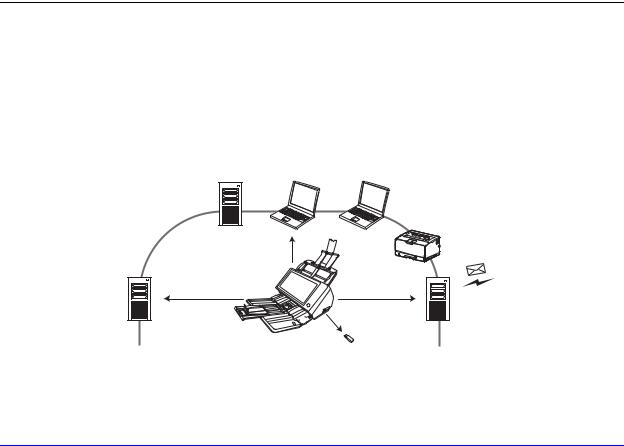
Introduction
Thank you for purchasing the Canon imageFORMULA ScanFront 400 network scanner.
Please read this manual thoroughly before using the scanner to familiarize yourself with its capabilities, and to make the most of its many functions. After reading this manual, store it in a safe place for future reference.
About ScanFront 400
The ScanFront 400 is a network scanner that you can use without connecting to a computer.
You can transfer the data of an image scanned with the ScanFront 400 to a shared folder on a server PC or client PC on the network or to an FTP server, send it to a printer for printing, or deliver it to a remote location via e-mail or Internet fax service. When using the scanner without a network environment, you can also save the image files to USB memory.
Shared Folder
(Server PC, Client PC)
Network |
Printer |
|
Save File |
Save File |
Send E-mail |
FTP Server |
Mail Server |
|
Internet Fax Service |
|
Save File |
ScanFront
USB Memory
Conceptual Diagram of the ScanFront
About the ScanFront 400 Web Application Mode
The ScanFront 400 is equipped with an operation mode called Web Application Mode.
If you want to switch to and use the Web Application Mode, contact your dealer.
6

Manuals for the Scanner
The following manuals are provided with the Canon ScanFront 400. Be sure to read these manuals thoroughly before using the scanner.
 Setup and Operation Guide*
Setup and Operation Guide*
Setup Guide
Describes the procedure for setting up the scanner for scanning. Set up the ScanFront in accordance with the Setup Guide. For details on the ScanFront, refer to the
Operation Guide and ScanFront 400 INSTRUCTIONS
(electronic manuals).
Operation Guide
Provides an overview of the functions of the scanner, and describes the basic operations for using the ScanFront. For details on the settings of the ScanFront, refer to the
ScanFront 400 INSTRUCTIONS (electronic manual).
*The printed version of Setup and Operation Guide may vary depending on your region. PDF files of the Setup and Operation Guide in other languages can be found on the application disc.
 INSTRUCTIONS (Electronic Manual): This
INSTRUCTIONS (Electronic Manual): This
Manual
Describes how to use the scanner, and includes instructions for configuring the scanner settings, as well as handling, maintenance, and troubleshooting information. This manual is stored as a PDF file on the supplied application disc and requires Adobe Reader to open. (You can download Adobe Reader from the Adobe Web site.)
Symbols Used in This Manual
The following symbols are used in this manual to explain procedures, restrictions, handling precautions, and instructions that should be observed for safety.
 WARNING
WARNING
Indicates a warning concerning operations that may lead to death or injury to persons if not performed correctly. To use the scanner safely, always pay attention to these warnings.
 CAUTION
CAUTION
Indicates a caution concerning operations that may lead to injury to persons, or damage to property if not performed correctly. To use the scanner safely, always pay attention to these cautions.
 IMPORTANT
IMPORTANT
Indicates operational requirements and restrictions. Be sure to read these items carefully to operate the scanner correctly, and avoid damage to the scanner.
 Hint
Hint
Indicates a clarification of an operation, or contains additional explanations for a procedure. Reading these notes is highly recommended.
7

How This Manual is Organized
This manual consists of the following chapters.
Chapter 1 Before Use
This chapter provides an overview of the ScanFront.
Chapter 2 ScanFront Setup
This chapter describes the setup procedures and Administrator Settings of the scanner.
Chapter 3 Handling
This chapter describes the types of documents that can be scanned, and the basic operations of the scanner.
Chapter 4 Operating Procedures
This chapter describes the basic operating procedures for the scanner.
Chapter 5 Administrator Settings
This chapter describes the Administrator Settings for the administrator to configure settings.
Chapter 6 User Settings
This chapter describes the User Settings for the administrator to configure settings.
Chapter 7 ScanFront Administration Tool for SF400
This chapter describes how to install and use ScanFront Administration Tool for SF400.
Chapter 8 Maintenance
This chapter describes how to clean the scanner and replace the consumable parts such as rollers.
Chapter 9 Troubleshooting
This chapter describes how to respond when problems occur or warning messages appear.
Chapter 10 Appendices
This chapter describes the scanner specifications.
8

Table of Contents |
|
||
Introduction.............................................................. |
6 |
||
|
About ScanFront 400............................................... |
6 |
|
|
About the ScanFront 400 Web Application Mode.... |
6 |
|
|
Manuals for the Scanner ......................................... |
7 |
|
|
Symbols Used in This Manual................................. |
7 |
|
|
How This Manual is Organized................................ |
8 |
|
Chapter 1 |
Before Use |
|
|
1. |
Important Safety Instructions............................. |
14 |
|
|
Installation Location............................................... |
14 |
|
|
Power |
.................................................................... |
15 |
|
Moving ...............................................the Scanner |
15 |
|
|
Handling ................................................................ |
15 |
|
|
Disposal................................................................. |
17 |
|
2. |
Features ..........................of the ScanFront 400 |
18 |
|
|
ScanFront .......................................................400 |
18 |
|
3. |
Names ..........................and Functions of Parts |
21 |
|
|
Front and ...........Document Feed and Eject Trays |
21 |
|
|
Rear....................................................................... |
|
22 |
4. |
Network ........................................Environment |
23 |
|
|
Network ............................................Environment |
23 |
|
|
Directory ......................................Service Support |
24 |
|
Chapter 2 |
ScanFront Setup |
|
|
1. |
Before ..........................Setting Up the Scanner |
26 |
|
|
Installation ...............................................Location |
26 |
|
|
Connecting ...................................the AC Adapter |
27 |
|
|
Connecting ..............................the Network Cable |
28 |
|
2. |
Turning .......................the Power ON and OFF |
29 |
|
|
Turning ...........................................the Power ON |
29 |
|
Turning the Power OFF ......................................... |
30 |
3. Configuring the Scanner Settings ..................... |
31 |
Administrator Settings ........................................... |
31 |
4. Configuring Administrator Settings.................... |
34 |
Logging In to the Administrator Settings................ |
34 |
Network Setting ..................................................... |
35 |
Administrator Password......................................... |
36 |
Backup/Restore Setting Information...................... |
37 |
Select Login Type.................................................. |
38 |
Roller Counter Reset ............................................. |
38 |
Format ScanFront.................................................. |
39 |
Network Test ......................................................... |
39 |
Chapter 3 Handling |
|
1. Documents ........................................................ |
41 |
Plain Paper ............................................................ |
41 |
Business Card ....................................................... |
42 |
Card (plastic) ......................................................... |
42 |
Passport ................................................................ |
42 |
2. Preparing the Scanner ...................................... |
43 |
Preparing the Document Feed Tray and |
|
Eject Tray .............................................................. |
43 |
Changing the Feed Method ................................... |
44 |
USB Port................................................................ |
44 |
3. Placing Documents ........................................... |
46 |
Placing a Document .............................................. |
46 |
Placing a Folded Document .................................. |
47 |
Placing a Long Document ..................................... |
48 |
Placing a Card ....................................................... |
48 |
Placing a Carrier Sheet ......................................... |
49 |
Placing a Carrier Sheet for Passports ................... |
50 |
4. Clearing a Paper Jam or Double Feed Error..... |
52 |
9

Chapter 4 Operating Procedures |
|
|
1. |
Flow of Scanner Operations.............................. |
56 |
2. |
Turning the Power ON and OFF ....................... |
57 |
|
Turning the Power ON........................................... |
57 |
|
Turning the Power OFF ......................................... |
58 |
3. |
Login Screen ..................................................... |
59 |
|
Login Screen Types............................................... |
59 |
|
When Using Server Authentication........................ |
60 |
|
List Type Login ...................................................... |
60 |
|
Key in Type Login.................................................. |
61 |
4. |
Screen Displayed after Login ............................ |
63 |
|
Home Screen......................................................... |
63 |
|
Job Button Screen ................................................. |
64 |
5. |
User Settings Screen ........................................ |
65 |
|
User Administration ............................................... |
65 |
|
Address Book Settings .......................................... |
66 |
|
Job Button Settings ............................................... |
66 |
|
Change Password ................................................. |
66 |
|
Show Operation History......................................... |
67 |
6. |
Scanning Procedures ........................................ |
68 |
|
Scanning From the Home Screen ......................... |
68 |
|
Scanning From the Job Button Screen.................. |
69 |
|
Address Selection Screen ..................................... |
69 |
|
USB Memory Screen............................................. |
71 |
|
Print Settings Screen............................................. |
72 |
|
Scanning................................................................ |
73 |
7. |
Registering and Editing Addresses ................... |
78 |
|
Registering a New Address ................................... |
78 |
|
Modifying an Address ............................................ |
83 |
|
Copying an Address .............................................. |
84 |
8. |
Scan / Send Settings......................................... |
85 |
Scan Settings ........................................................ |
86 |
File Formats........................................................... |
95 |
Security Settings for PDF Files.............................. |
97 |
Send Settings ........................................................ |
98 |
Batch separation using patch code sheets.......... |
101 |
Using patch code sheets ..................................... |
102 |
Chapter 5 Administrator Settings |
|
1. Administrator Settings ..................................... |
105 |
2. User Administration......................................... |
107 |
Registering New Users........................................ |
108 |
Editing Users ....................................................... |
114 |
Restricting User Functions .................................. |
115 |
Deleting Users ..................................................... |
117 |
Deleting by Server Synchronization .................... |
117 |
Exporting Users ................................................... |
118 |
Importing Users ................................................... |
119 |
3. Address Book Settings.................................... |
120 |
Registering New Addresses ................................ |
120 |
Modifying Addresses ........................................... |
120 |
Copying Addresses ............................................. |
121 |
Deleting Addresses ............................................. |
121 |
Exporting Address Books .................................... |
122 |
Importing Address Books .................................... |
123 |
4. Job Button Settings ......................................... |
124 |
Registering New Job Buttons .............................. |
124 |
Copying Job Buttons ........................................... |
127 |
Editing Jobs ......................................................... |
128 |
Exporting Job Buttons ......................................... |
129 |
Importing Job Buttons.......................................... |
130 |
5. Device Configuration....................................... |
131 |
Network Setting ................................................... |
132 |
10

Language/Timezone............................................ |
133 |
Date/time settings................................................ |
133 |
Auto Logout ......................................................... |
134 |
SNMP Settings .................................................... |
134 |
6. Server Settings................................................ |
140 |
E-mail Server....................................................... |
141 |
FAX...................................................................... |
142 |
Authentication Server .......................................... |
143 |
Address Book Server........................................... |
144 |
FTP Server .......................................................... |
145 |
HTTP Proxy Server ............................................. |
146 |
FTP Proxy Server................................................ |
146 |
7. System Settings .............................................. |
147 |
Backing Up All Settings ....................................... |
148 |
Restoring All Settings .......................................... |
148 |
Export Error Log .................................................. |
149 |
Version Information ............................................. |
149 |
Version Up........................................................... |
149 |
8. System Administration..................................... |
151 |
Administrator Settings ......................................... |
151 |
9. Certificates ...................................................... |
152 |
Delete Certificates ............................................... |
152 |
10. Private Key .................................................... |
153 |
Delete Private Key............................................... |
153 |
11. Device Operation Screen .............................. |
154 |
Device detail settings........................................... |
155 |
Setting a Password.............................................. |
156 |
IEEE802.1X setting ............................................. |
156 |
Accessing from an External Terminal’s Web |
|
Browser ............................................................... |
157 |
Chapter 6 User Settings |
|
|
1. |
User Settings................................................... |
160 |
2. |
User Administration......................................... |
161 |
3. |
Address Book Settings.................................... |
163 |
|
Registering New Addresses ................................ |
164 |
|
Modifying Addresses ........................................... |
164 |
|
Copying Addresses ............................................. |
164 |
4. |
Job Button Settings ......................................... |
165 |
|
Registering New Job Buttons .............................. |
165 |
|
Copying Job Buttons ........................................... |
165 |
|
Editing Jobs ......................................................... |
166 |
|
Exporting Job Buttons ......................................... |
166 |
|
Importing Job Buttons.......................................... |
166 |
Chapter 7 ScanFront Administration Tool for |
||
|
SF400 |
|
1. |
About ScanFront Administration Tool for |
|
|
SF400.............................................................. |
168 |
2. Installing ScanFront Administration Tool for |
|
|
|
SF400.............................................................. |
169 |
|
System Requirements ......................................... |
169 |
|
Installation ........................................................... |
169 |
3. |
ScanFront Administration Tool for SF400 |
|
|
Setup............................................................... |
171 |
|
Starting ScanFront Administration Tool for |
|
|
SF400 .................................................................. |
171 |
|
Registering ScanFront Scanners......................... |
171 |
4. |
Managing the ScanFront Scanners................. |
173 |
|
Selecting a ScanFront ......................................... |
173 |
|
Checking ScanFront Status................................. |
173 |
|
Entering Passwords............................................. |
174 |
11

|
Changing IP Addresses or Device Names .......... |
175 |
|
|
Checking Detailed Information on |
|
|
|
the ScanFront...................................................... |
175 |
|
|
Displaying the Web Menu.................................... |
176 |
|
|
Batch Processing................................................. |
176 |
|
|
Importing/Exporting Administration Data ............. |
178 |
|
|
Main Screen Display/Non-Display ....................... |
178 |
|
Chapter 8 |
Maintenance |
|
|
1. |
Routine Cleaning............................................. |
180 |
|
|
Cleaning the Scanner Unit................................... |
180 |
|
|
Cleaning the Touch Panel ................................... |
180 |
|
|
Cleaning the Scanning Glass and Rollers ........... |
181 |
|
|
Cleaning the Retard Roller .................................. |
183 |
|
|
Cleaning the Feed Roller..................................... |
185 |
|
2. |
Replacing the Rollers ...................................... |
187 |
|
|
Exchange Roller Kit............................................. |
187 |
|
|
Checking the Page Count and Resetting |
|
|
|
the Counter.......................................................... |
188 |
|
Chapter 9 |
Troubleshooting |
|
|
1. |
Troubleshooting............................................... |
191 |
|
2. |
Error Messages ............................................... |
197 |
|
3. |
Initializing ScanFront ....................................... |
202 |
|
Chapter 10 |
Appendices |
|
|
1. |
Specifications .................................................. |
204 |
|
|
Unit Specifications ............................................... |
204 |
|
|
Network Specifications ........................................ |
206 |
|
|
Transfer Destinations .......................................... |
206 |
|
|
AC Adapter (100 to 240 V type) .......................... |
206 |
|
|
Consumable Parts ............................................... |
206 |
|
Optional Equipment ............................................. |
206 |
About the Flatbed Scanner Unit 102/201 ............ |
207 |
External Dimensions............................................ |
208 |
2. Index ............................................................... |
209 |
12

Chapter 1 Before Use
1. |
Important Safety Instructions ............................. |
14 |
|
Installation Location ............................................... |
14 |
|
Power ..................................................................... |
15 |
|
Moving the Scanner ............................................... |
15 |
|
Handling ................................................................. |
15 |
|
Disposal ................................................................. |
17 |
2. |
Features of the ScanFront 400 .......................... |
18 |
|
ScanFront 400........................................................ |
18 |
3. |
Names and Functions of Parts .......................... |
21 |
|
Front and Document Feed and Eject Trays ........... |
21 |
|
Rear ....................................................................... |
22 |
4. |
Network Environment ........................................ |
23 |
|
Network Environment............................................. |
23 |
|
Directory Service Support ...................................... |
24 |
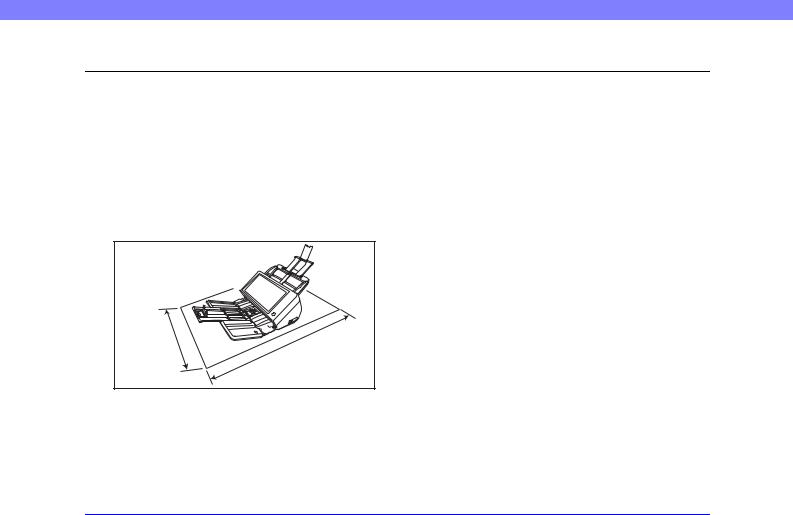
Chapter 1 Before Use
1. Important Safety Instructions
To ensure the safe operation of this scanner, be sure to read the safety warnings and precautions described below.
Installation Location
The performance of this scanner is affected by the environment in which it is installed. Make sure that the location where the scanner is installed meets the following environmental requirements.
●Provide adequate space around the scanner for operation, maintenance, and ventilation.
At least |
|
15.75" |
|
(40 cm) |
At least |
|
|
|
25.59" (65 cm) |
●Avoid installing the machine in direct sunlight. If this is unavoidable, use curtains to shade the scanner.
●Avoid locations where a considerable amount of dust accumulates.
●Avoid warm or humid locations, such as in the vicinity of a water faucet, water heater, or humidifier, and avoid locations where the fumes from ammonia, paint thinner, or other volatile chemicals may be present.
●Avoid locations that are subject to vibration.
●Avoid exposing the scanner to rapid changes in temperature. If the room in which the scanner is installed is cold but rapidly heated, water droplets (condensation) may form inside the scanner. This may result in a noticeable degradation in scanning quality.
The following conditions are recommended for optimal scanning quality:
Room temperature: 10 °C to 32.5 °C (50 °F to 90.5 °F)
Humidity: 20% to 80% RH
●Avoid installing the scanner near equipment that generates a magnetic field (e.g. speakers, televisions, or radios).
14

Chapter 1 Before Use
Power
●Connect only to a power outlet of the rated voltage and power supply frequency (either 120 V, 60 Hz or 220-240 V, 50/60 Hz, depending on your region).
●Do not connect other electrical equipment to the same power outlet to which the scanner is connected. Also, when using an extension cord, make sure that the extension cord is rated for the current requirements of the scanner.
●Never try to disassemble the AC adapter or modify it in any way, as this is extremely dangerous.
●The power cord and AC adapter may become damaged if they are often stepped on or if heavy objects are placed on them. Continued use of a damaged power cord and AC adapter can lead to an accident, such as a fire or electrical shock.
●Do not use the power cord while it is coiled.
●Do not pull directly on the power cord. When disconnecting the power cord, grasp the plug and remove it from the outlet.
●Keep the area around the power plug clear of objects so that the power cord can be disconnected easily in an emergency.
●Use only the AC adapter provided with this scanner. Also, do not use the AC adapter provided with the scanner with any other electrical devices.
Model: MG1-5039
●If you have any questions regarding the power supply, contact your local authorized Canon dealer or service representative for further information.
Moving the Scanner
●When moving the scanner, always hold it with both hands to avoid dropping it. The weight of the scanner unit is approximately 9.92 lbs (4.5 kg).
●Before moving the scanner, make sure the document tray is closed and the interface cable and AC adapter are disconnected. If the scanner is transported with these items connected, the plugs and connectors may be damaged due to excessive force applied to them during movement.
Handling
 WARNING
WARNING
Note the following precautions whenever using the scanner. Failure to do so may result in a fire or electric shock.
■Never use alcohol, benzene, paint thinner, aerosol sprays, or any other highly flammable substance near the scanner.
■Do not cut, damage, or modify the power cord or AC adapter. Do not place heavy objects on the power cord or AC adapter, and do not pull or excessively bend the power cord.
15

Chapter 1 Before Use
■The supplied power cord set is intended for use with this scanner only. Do not use it with other electronic equipment. In addition, do not use power cord sets other than the one supplied with the scanner. Doing so may result in fire or electric shock.
■Never connect the power cord when your hands are wet.
■Do not connect the scanner to a multiplug power strip.
■Do not knot or coil the power cord, as this may result in a fire or electric shock. When connecting the power cord, make sure that the power plug is securely and completely inserted into the power outlet.
■Never try to take the scanner apart or modify it in any way.
■Never try to take the AC adapter apart or modify it in any way, as this is dangerous and may lead to a fire or electric shock.
■Do not use flammable aerosol sprays near the scanner.
■When cleaning the scanner, turn the power OFF and disconnect the power cord from the power supply.
■Clean the scanner using a slightly dampened cloth which has been well wrung out. Never use alcohol, benzene, paint thinner, or any other flammable substances.
■If the scanner makes strange noises, or gives off, smoke, heat, or strange odors, or the scanner does not function or other abnormalities occur when you use the machine, immediately turn the power OFF, and disconnect the power plug from the power outlet. Then, contact your local authorized Canon dealer or service representative for further information.
■Do not drop the scanner, or subject it to impact or strong shock. Should the scanner ever become damaged, immediately turn the power OFF, and disconnect the power plug from the power outlet. Then, contact your local authorized Canon dealer or service representative to have the unit serviced.
■Before moving the scanner, make sure to turn the power OFF, and disconnect the power plug from the power outlet.
 CAUTION
CAUTION
■Do not install the scanner on a surface that is unstable or tilted, or in an area subject to excessive vibrations, as this may cause the scanner to fall, resulting in personal injury or damage to the scanner.
■Do not block the ventilation openings. Doing so could cause the scanner to overheat, creating a risk of fire.
16

Chapter 1 Before Use
■Never place small metal objects such as staples, paper clips, or jewelry on the scanner. These items may fall into the scanner, and cause a fire or electric shock. Should such objects ever fall inside the scanner, immediately turn the power OFF, and disconnect the power plug from the power outlet. Then, contact your local authorized Canon dealer or service representative to have the unit serviced.
■Do not install the scanner in a humid or dusty location. Doing so may result in a fire or electric shock.
■Do not place objects on top of the scanner, as they may tip over and fall, resulting in personal injury.
■Do not use the scanner with a power supply voltage other than 120/220-240 VAC. Doing so might cause fire or electric shock.
■When disconnecting the power cord, grasp it firmly by its plug. Do not pull directly on the power cord, as this may damage or expose the cord’s internal wiring, resulting in a fire or electric shock.
■Leave sufficient space around the power plug so that it can be disconnected easily. If objects are placed around the power plug, you will be unable to disconnect it in an emergency.
■Do not allow water or flammable substances (alcohol, paint thinner, benzene, etc.) to spill into the scanner, as this may result in a fire or electric shock.
■Turn OFF the power for safety when not using the scanner for a long period of time, such as overnight. Also, turn OFF the power, and disconnect the AC adapter from the scanner and disconnect the power cord from the power outlet for safety when the machine will not be used for an extended period of time, such as during consecutive holidays.
■Do not wear loose clothing or jewelry that may get caught in the scanner while you are using it. This may result in personal injury. Be extra careful of neckties and long hair. If anything becomes caught in the scanner, immediately disconnect the power cord to stop the scanner.
■Be careful when placing paper in the scanner and when removing jammed paper. It is possible to cut your hand on the edge of a sheet of paper.
Disposal
●Prior to disposing of the scanner, initialize the scanner to ensure that the registered data is deleted.
●When disposing of the scanner, make sure to follow all local ordinances and laws or consult with the retailer who sold you the scanner.
17

Chapter 1 Before Use
2. Features of the ScanFront 400
The main features of the ScanFront 400 are described below.
ScanFront 400
●Compact Network Document Scanner
The network document scanner has a compact design of 12.01" (W) × 9.96" (D) × 8.03" (H) (305 mm (W) × 253 mm (D) × 204 mm (H)) when the feed tray is detached. You can scan documents in a range of sizes from business cards to A4/LTR size.
●Supports Transfer to a Variety of Destinations
You can transfer scanned image files to the following types of destinations via a network.
–Shared folders
–FTP Servers
–E-mail addresses
–Fax (via an Internet fax service)
●Variety of Scanning Modes
The scanner is equipped with five scanning modes: Black and White, Error Diffusion, Text Enhance, Gray, and Color.
●Long Document Scanning
The scanner is equipped with a scanning mode that can
automatically detect long document sizes.
*The available scanning modes vary depending on the file format of the image to be transferred.
●Fast Document Feeding
The scanner can scan a maximum of 45 A4 documents per minute.
*Scanning conditions: Black and white, simplex, 200 dpi
●High Image Quality
The 600 dpi optical resolution sensor incorporated in the scanner enables documents to be scanned with high image quality.
●Supports USB Memory
The scanner supports saving image files to USB memory to enable you to move them to destinations not connected to or not using a network.
●Touch Panel Operation
The 10.1-inch TFT WSVGA (1024 × 600 dots) screen with a touch panel enables you to perform all scanner operations by touching the screen.
●Supports Mouse and Keyboard
In addition to touch-panel operation, you can also use a mouse and keyboard to operate the scanner. (See p. 44.)
●ScanFront Administration Tool for SF400
By installing the supplied ScanFront Administration Tool for SF400 software, you can simultaneously manage multiple ScanFront scanners on the network.
*Set [Allow remote operation] to [ON]. (See p. 155.)
18

Chapter 1 Before Use
●Job Buttons
Pre-registering destinations and scan conditions as jobs enables you to scan by selecting a job button.
●Shared Address Book and Shared Job Button
The Shared Address Book and Shared Job Buttons are available for use by all users.
●My Address Book and My Job Button
In addition to the address book and job buttons shared by all users, a My Address Book and My Job Button are available for each user.
●Supports Directory Services
The scanner supports directory services (Active Directory and OpenLDAP), which enables you to reference and use user accounts and e-mail addresses registered on a domain server and LDAP server.
●Functional Restrictions
The scanner enables you to restrict, for example, the destinations and Home screen available to each user.
●Auto Size Detection
The scanner can detect the size of a scanned document and erase the white space around the image.
●Auto Color Detection
The scanner can automatically detect whether a document is color or black and white, and save the scanned images accordingly.
●Folio Scanning
The scanner can scan both sides of a document folded in half and create a single scanned image.
●Double Feed Detection by Length
When the scanner detects a double feed by comparing the lengths of documents, it stops feeding.
*Using the length of the first document as a reference, the scanner detects a double feed when a document of a different length is fed.
●Double Feed Detection by Ultrasonic Function
In addition to the double feed detection function that compares the lengths of documents, the scanner is equipped with a double feed detection function that uses an ultrasonic sensor.
●Double Feed Retry
When a double feed has occurred, this function returns the document to the document feeder and re-feeds the pages.
●Skip Blank Page Function
The scanner scans both sides of a document and skips saving the image of any side it determines to be a blank page.
●Deskew
If the scanner detects from a scanned image that the document was fed askew, the image is straightened.
●Image Rotation
The scanner can rotate a scanned image in 90° increments, or detect the text orientation within the document, and then rotate the image in 90° increments so that the orientation of the text is correct.
●Eliminates Bleed-Through
The scanner prevents the images on the reverse side of thin documents from appearing on the scanned pages.
19

Chapter 1 Before Use
●Dropout and Color Enhancement Functions
The scanner is equipped with a dropout function that allows you to specify one color (red, blue, or green) to omit, and a function to enhance a specified color when scanning.
●Text Enhance Mode
The background color of the text are processed to enhance the text portions and make them easy to read.
*This function may not work effectively for some documents.
●Text/Line Thickness Correction Function
This function corrects the thickness of text and lines when the text and lines are not easily distinguishable in scanned images.
●Card Scanning
You can scan credit cards and IC cards that conform to ISO standards.
●Passport Scan
You can scan passports using the optional carrier sheet (for passports).
●Prescan
This function prescans the first page of a document at the start of scanning, and then stops scanning so that you can view the results to adjust the brightness and contrast before scanning the entire document.
●Auto Start
The scanner is equipped with an auto start function, which enables scanning to be automatically started when a document placed in the feeder is detected.
20
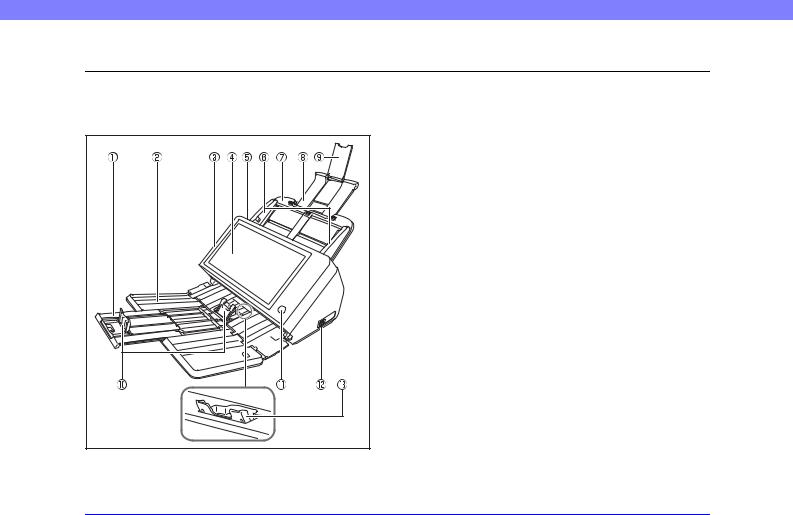
Chapter 1 Before Use
3. Names and Functions of Parts
The names and functions of the parts of the ScanFront are shown below.
Front and Document Feed and Eject Trays
bDocument Eject Tray
Open this tray when using the ScanFront.
c Panel Unit
Open this when there is a paper jam or to perform maintenance. (See p. 53.)
d Touch Panel
Touch this screen to operate the ScanFront.
eLock Lever
Locks the panel unit. Pull the lever toward you to unlock
the panel unit. (See p. 53.) f Document Guides
Adjust these to match the width of the document. (See p. 47.)
g Document Feed Tray
Place documents here. (See p. 43.) h Feed Support
Pull this out to support loaded documents. i Feed Extension Support
Open this when placing long paper in the scanner.
aTray Extension
Open this to prevent scanned documents from slipping off.
21

Chapter 1 Before Use
jDocument Eject Stopper
This prevents the ejected documents from falling out of the document eject tray and aligns their leading edges. It can be moved to match the length of the document. The angle of the document eject stopper on the document eject tray will change depending on the volume of documents ejected.
kPower button
Press this to turn on the scanner. When pressed, the power indicator is lit.
Use the Power OFF button on the touch panel to turn the power OFF.
The power button lights or flashes as follows depending on the scanner status.
Power Button Indication |
Description |
|
|
Lit |
Power is on |
|
|
Flashing |
Low power mode |
|
|
lUSB Port (Front)
Connect a USB1.1/Hi-Speed USB2.0 compatible USB memory device, USB keyboard, or USB mouse.
mEject Tray Support
Open this when scanning multiple documents of varying sizes at one time. Scanned documents are arranged in the tray by supporting and lifting up the document eject tray from the bottom.
Rear
nKensington Slot
This is an anti-theft slot that enables a key chain or lock to be connected to prevent theft.
oPower Connector (24 V DC)
Connect the plug of the supplied AC adapter. (See p. 27.)
pService Switch
This is a service switch. Do not insert any object into this hole.
qLAN Port (RJ-45)
Connect an RJ-45 (10Base-T/100Base-TX/1000Base-T) compatible network cable. (See p. 28.)
rUSB Ports (Rear Right)
Connect a USB1.1/Hi-Speed USB2.0 compatible USB memory device, USB keyboard, or USB mouse.
22

Chapter 1 Before Use
4. Network Environment
The network environment required to use the ScanFront is described below. To obtain details on your network environment, contact your network administrator.
Network Environment
●Network Protocol
The scanner uses TCP/IP protocol to connect to the network.
●IP Address Assignment
The TCP/IP protocol uses one IP address for each device connected to the network. Consult your network administrator to determine the IP address to assign to the scanner.
●DHCP Support
The scanner supports DHCP (Dynamic Host Configuration Protocol). A DHCP server provides a network environment in which IP addresses can be obtained automatically from the DHCP server, so there is no need to set an IP address for the scanner.
*The number of IP addresses that can be obtained using DHCP is managed by the network administrator. For details, consult your network administrator.
●SMTP (E-mail) Server
The scanner supports an SMTP server, so you can send image files directly from the scanner by e-mail.
●FTP Server
Transmission may not be possible depending on firewall settings.
●Fax
Scanned images can be sent to specified addresses as fax documents by sending e-mails that include the scanned images as attachments to an Internet fax service. Therefore, you must specify message formats and addresses in the method prescribed by your Internet fax service.
●Printer
By using the FTP print function of a printer connected to the same network with the ScanFront, you can print scanned images.
●1000Base-T Support
The scanner supports 1000Base-T. However, communication may be slower than the communication speed of the network, depending on the other devices connected to the network and the type of hub.
23

Chapter 1 Before Use
Directory Service Support
●Active Directory
Active Directory is a directory service adopted by Windows 2000, and information registered to Active Directory can be used on other computers. The ScanFront allows user information registered to the domain server registered as the authentication server to be used for authentication to log in to the ScanFront.
*A domain server that uses Windows NT Server for the operating system cannot be registered as an authentication server.
●OpenLDAP Server
The scanner supports OpenLDAP servers that can be connected to with the LDAP (Lightweight Directory Access Protocol) protocol.
You can authenticate ScanFront users and reference e- mail addresses for registration to the address book using the user information registered on the OpenLDAP server.
24

Chapter 2 ScanFront Setup
1. Before Setting Up the Scanner .......................... |
26 |
Installation Location ............................................... |
26 |
Connecting the AC Adapter ................................... |
27 |
Connecting the Network Cable .............................. |
28 |
2. Turning the Power ON and OFF........................ |
29 |
Turning the Power ON ........................................... |
29 |
Turning the Power OFF.......................................... |
30 |
3. Configuring the Scanner Settings ...................... |
31 |
Administrator Settings ............................................ |
31 |
4. Configuring Administrator Settings .................... |
34 |
Logging In to the Administrator Settings ................ |
34 |
Network Setting...................................................... |
35 |
Administrator Password ......................................... |
36 |
Backup/Restore Setting Information ...................... |
37 |
Select Login Type .................................................. |
38 |
Roller Counter Reset.............................................. |
38 |
Format ScanFront .................................................. |
39 |
Network Test .......................................................... |
39 |
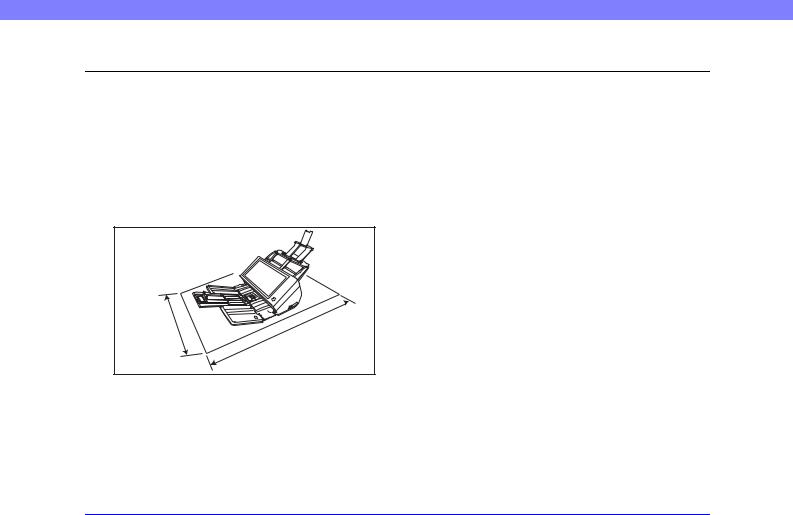
Chapter 2 ScanFront Setup
1. Before Setting Up the Scanner
Before setting up the scanner, you need to move it to the installation site, and connect the AC adaptor and network cable.
Installation Location
The performance of this scanner is affected by the environment in which it is installed. Make sure that the location where the scanner is installed meets the following environmental requirements
●Provide adequate space around the scanner for operation, maintenance, and ventilation.
At least |
|
15.75" |
|
(40 cm) |
At least |
|
25.59" (65 cm) |
●Avoid installing the machine in direct sunlight. If this is unavoidable, use curtains to shade the scanner.
●Avoid locations where a considerable amount of dust accumulates.
●Avoid warm or humid locations, such as in the vicinity of a water faucet, water heater, or humidifier, and avoid locations where the fumes from ammonia, paint thinner, or other volatile chemicals may be present.
●Avoid locations that are subject to vibration.
●Avoid exposing the scanner to rapid changes in temperature. If the room in which the scanner is installed is cold but rapidly heated, water droplets (condensation) may form inside the scanner. This may result in a noticeable degradation in scanning quality.
The following conditions are recommended for optimal scanning quality:
Room temperature: 10 °C to 32.5 °C (50 °F to 90.5 °F)
Humidity: 20% to 80% RH
●Avoid installing the scanner near equipment that generates a magnetic field (e.g. speakers, televisions, or radios).
26

Chapter 2 ScanFront Setup
Connecting the AC Adapter
Follow the procedure shown below to connect the AC adapter.
 CAUTION
CAUTION
Make sure to use only the AC adapter and power cord included with the scanner.
The shape of the |
power plug varies |
by country and |
region. |
a Connect the power cord and AC adapter.
b Insert the plug of the AC adapter into the power connector. c Connect the power cord to the wall outlet.
27

Chapter 2 ScanFront Setup
Connecting the Network Cable
Insert the network cable connector (RJ-45) into the LAN port.
28
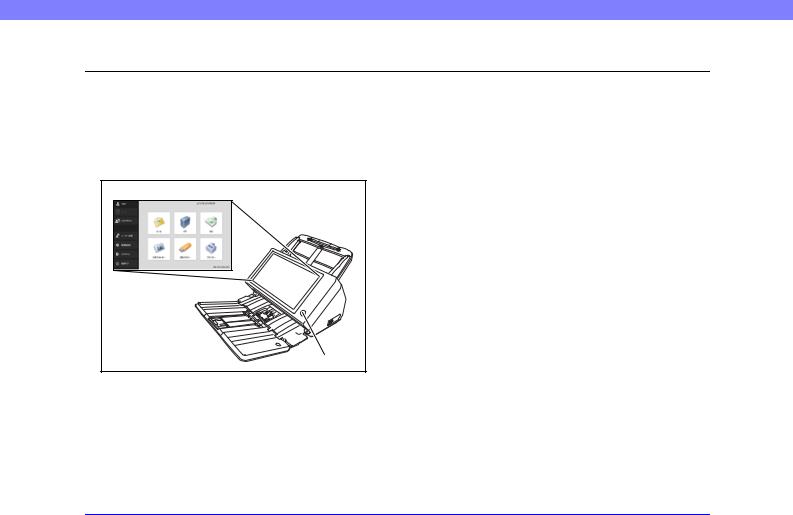
Chapter 2 ScanFront Setup
2. Turning the Power ON and OFF
Use the power button to turn the scanner ON, and press the [Power off] button on the touch panel to turn it OFF.
Turning the Power ON
Press the power button to turn the scanner ON. The power button lights, and the Home screen or the login screen appears.
Home screen |
Power button |
 IMPORTANT
IMPORTANT
•Wait a moment for the Home screen to appear after pressing the power button to turn the scanner ON.
•When the power indicator is lit but nothing appears on the touch panel, Display Off has activated to turn the panel display off. You can touch the touch panel to restore the display. (See “Adjust the wait time until the display automatically turns off.” on p. 155.)
•When the power indicator is flashing but nothing appears on the touch panel, the Low Power mode has activated to temporarily stop scanner operations. To switch out of Low Power mode, press the power button. (See “Adjust the wait time until the Low Power Mode.” on p. 155.)
•The touch panel display may appear dark at times. In such cases, touching the panel will restore it to its normal brightness.
29
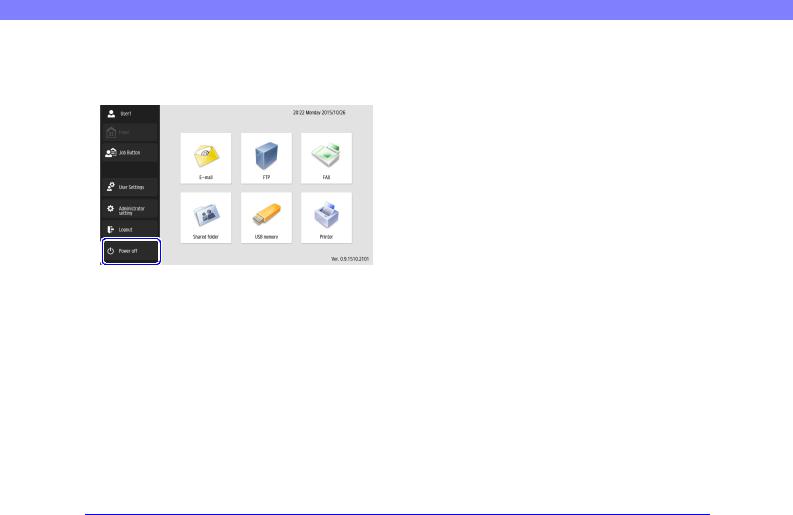
Chapter 2 ScanFront Setup
Turning the Power OFF
Press the [Power off] button displayed at the bottom left of the panel to turn the scanner OFF.
 IMPORTANT
IMPORTANT
•When restarting the scanner, wait at least 5 seconds after turning the power OFF before turning it ON again.
•If the scanner stops responding, you can press and hold the power button to force shutdown. In such cases, any configured settings, operation histories, or error logs may be lost, and startup may not be possible. Pressing and holding the power button to force shutdown may result in malfunction, so do not perform this operation under normal circumstances.
•After ScanFront transitions to Low Power Mode while not connected to a network, power will automatically turn OFF when the scanner is not operated for approximately 4 hours.
30
